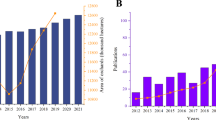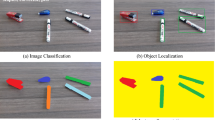Abstract
Food has a direct impact on an individual's life and is a significant area for the research community. Computational techniques in food-related computing are performed to address various food-related issues in the field of agronomy, medicine, biology etc. In this paper, we present a comprehensive review of research exclusively on segmentation techniques used for food computing. This paper illustrates the viable segmentation techniques used for food image segmentation. It also provides a comprehensive review of the same. A relevant survey on 66 research papers has been done to provide different food image segmentation techniques. A comparative study among these techniques is also done based on different parameters like type of algorithm, segmentation technique, dataset, and accuracy. Moreover, this paper focuses on research challenges in food recognition. Also a framework has been proposed in this paper to overcome the problem of watershed and OTSU algorithm.












Similar content being viewed by others
References
Tay W, Kaur B, Quek R, Lim J, Henry CJ (2020) Current Developments in digital quantitative volume estimation for the optimisation of dietary assessment. Nutrients 12(4):1167
Aizawa K, Maruyama Y, Li H, Morikawa C (2013) Food balance estimation by using personal dietary tendencies in a multimedia food log. IEEE Trans Multimedia 15(8):2176–2185. https://doi.org/10.1109/TMM.2013.2271474
Ciocca G, Napoletano P, Schettini R (2017) Food recognition: a new dataset, experiments, and results. IEEE J Biomed Health Inform 21(3):588–598. https://doi.org/10.1109/JBHI.2016.2636441
Silva BVRE, Rad MG, McCabe M, Pan K, Cui J (2018) A mobile-based diet monitoring system for obesity management. J Health Med Informat 9:307. https://doi.org/10.4172/2157-7420.1000307
Liu C, Cao Y, Luo Y, Chen G, Vokkarane V, Ma Y (2016) In: Proceedings of the ICOST 2016,Wuhan, China
Kagaya H, Aizawa K, Ogawa M (2014) Food detection and recognition using convolutional neural network. In: Proceedings of the MM’14, Orlando, FL, USA, 3–7 November 2014
Situju SF, Takimoto H, Sato S, Yamauchi H, Kanagawa A, Lawi A (2019) Food constituent estimation for lifestyle disease prevention by multi-task CNN. Appl Artif Intell 33(8):732–746
Garey MR, Johnson DS (1979) Computers and intractability: a guide to the theory of NP-completeness. W.H.Freeman, New York
Javed A, Larijani H, Wixted A (2018) Improving Energy Consumption of a Commercial Building with IoT and Machine Learning. IT Profess 20(5):30–38. https://doi.org/10.1109/MITP.2018.053891335
Mezgec S, Seljak BK (2019) Using deep learning for food and beverage image recognition. In: 2019 IEEE international conference on big data (Big Data) pp 5149–5151
Tang J, Deng C, Huang G (2016) Extreme learning machine for multilayer perceptron. IEEE Trans Neural Netw Learn Syst 27(4):809–821. https://doi.org/10.1109/TNNLS.2015.2424995
Niyogi P, Girosi F, Poggio T (1998) Incorporating prior information in machine learning by creating virtual examples. Proc IEEE 86(11):2196–2209. https://doi.org/10.1109/5.726787
Merzougui M, El Allaoui A (2019) Region growing segmentation optimized by evolutionary approach and maximum entropy. Procedia Comput Sci 151:1046–1051
Yunus R et al (2019) A framework to estimate the nutritional value of food in real time using deep learning techniques. IEEE Access 7:2643–2652. https://doi.org/10.1109/ACCESS.2018.2879117
Park SJ, Palvanov A, Lee CH, Jeong N, Cho YI, Lee HJ (2019) The development of food image detection and recognition model of Korean food for mobile dietary management. Nurs Res Pract 13(6):521–528
Mery D, Pedreschi F (2005) Segmentation of colour food images using a robust algorithm. J Food Eng 66(3):353–360
Castelman KR (2003) Digital image processing. Tsinghua University Press, Beijing
Chan FHY, Lam FK, Zhu H (1998) Adaptive thresholding by variational method. IEEE Trans Image Process 7(3):468–473
Lee SU, Chung SY, Park RH (1990) A comparative performance study of several global thresholding techniques for segmentation. Comput Vis Gr Image Process 52:171–190
Chow CK, Kaneko T (1972) Automatic boundary detection of left ventricle from cineangiograms. Comput Biomed Res 5:338–410
Fernando SMX, Monro DM (1982) Variable thresholding applied to angiography. In: Proceedings of 6th international conference on pattern recognition
Morais RM, Pedro J (2018) Machine learning models for estimating quality of transmission in DWDM networks. IEEE/OSA J Opt Commun Netw 10(10):D84–D99. https://doi.org/10.1364/JOCN.10.000D84
Krummenacher G, Ong CS, Koller S, Kobayashi S, Buhmann JM (2018) Wheel defect detection with machine learning. IEEE Trans Intell Transp Syst 19(4):1176–1187. https://doi.org/10.1109/TITS.2017.2720721
Liu T, Yang Y, Huang G, Yeo YK, Lin Z (2016) Driver distraction detection using semi-supervised machine learning. IEEE Trans Intell Transp Syst 17(4):1108–1120. https://doi.org/10.1109/TITS.2015.2496157
Chalup SK, Murch CL, Quinlan MJ (2007) Machine learning with aibo robots in the four-legged league of RoboCup. IEEE Trans Syst Man Cybern Part C (Appl Rev) 37(3):297–310. https://doi.org/10.1109/TSMCC.2006.886964
Moubayed M, Injadat A, Nassif AB, Lutfiyya H, Shami A (2018) E-learning: challenges and research opportunities using machine learning and data analytics. IEEE Access 6:39117–39138. https://doi.org/10.1109/ACCESS.2018.2851790
Liang KH, Mao JJW (1995) Image thresholding by minimizing the measures of fuzziness. Pattern Recogn 28(1):41–51
Abutaleb AS (1989) Automatic thresholding of gray-level pictures using two dimensional entropy. Comput Vis Gr Image Process 47:22–32
Muhammad NAAN, Lee CP, Lim KM, Razak SFA (2017) Malaysian food recognition and calorie counter application. In: 2017 IEEE 15th student conference on research and development (SCOReD), Putrajaya, 2017, pp 445–450. https://doi.org/10.1109/SCORED.2017.8305442
Gonzalez RC, Woods RE (2008) Digital image processing. Prentice-Hall, Englewood Cliffs
Bhargavi K, Jyothi S (2014) A survey on threshold based segmentation technique in image processing. Int J Innov Res Dev 3(12):234–239
Kittler J, Illingworth J (1986) Minimum error thresholding. Pattern Recogn 19(1):41–47
Kawano Y, Yanai K (2015) Foodcam: a real-time food recognition system on a smartphone. Multimedia Tools Appl 74(14):5263–5287
Muthukrishnan R, Radha M (2011) Edge detection techniques for image segmentation. Int J Compu Sci Inf Technol 3(6):259
Nakagawa Y, Rosenfeld A (1979) Some experiments on variable thresholding. Pattern Recognit 11:191–204
Chow CK, Kaneko T (1972) Boundary detection of radiographic images by a threshold method. In: Proceedings, ZFZP congress, vol 71, pp 130–134
Pun T (1981) Entropic thresholding: a new approach. Comput Vis Gr Image Process 16:210–239
Kittler J, Illingworth J (1986) Minimum error thresholding. Pattern Recogn 19:41–47
Brindha B, Raghuraman G (2013) Region based lossless compression for digital images intelemedicine application. In: 2013 international conference on communication and signal processing
Chseke I, Fazekas Z (1990) Comments on gray-level thresholding of images using a correlation criterion. Pattern Recogn Lett 11:709–710
Pun T (1980) A new method for gray-level picture thresholding using the entropy of the histogram. Signal Process 2:223–237
Dehariya VK, Shrivastava SK, Jain RC (2010) Clustering of image data set using K-means and fuzzy K-means algorithms. In: International conference on CICN, pp 386–391
e Silva BVR, Rad MG, Cui J, McCabe M, Pan K (2018) A mobile-based diet monitoring system for obesity management. J Health Med Inf 9(2):307
Tan KS, Isa NAM (2011) Color image segmentation using histogram thresholding-fuzzy C-means hybrid approach. Pattern Recogn 44:1–15
Maione C, Nelson DR, Barbosa RM (2019) Research on social data by means of cluster analysis. Appl Comput Inf 15(2):153–162
Kapoor A, Singhal A (2017) A comparative study of K-means, K-means++ and fuzzy C-means clustering algorithms. In: 2017 3rd international conference on computational intelligence and communication technology (CICT), pp 1–6
Pouladzadeh P, Shirmohammadi S, Al-Maghrabi R (2014) Measuring calorie and nutrition from food image. IEEE Trans Instrum Meas 63(8):1947–1956
Ganesan P, Sajiv G (2017) A comprehensive study of edge detection for image processing applications. In: 2017 international conference on innovations in information, embedded and communication systems (ICIIECS), pp 1–6
Ansari MA, Kurchaniya D, Dixit M (2017) A comprehensive analysis of image edge detection techniques. Int J Multimedia Ubiquitous Eng 12(11):1–12
He H, Kong F, Tan J (2016) DietCam: multiview food recognition using a multikernel SVM. IEEE J Biomed Health Inform 20(3):848–855. https://doi.org/10.1109/JBHI.2015.2419251
Dehais J, Anthimopoulos M, Mougiakakou S (2016) Food image segmentation for dietary assessment. In: ARTORG center for biomedical engineering research, University of Bern, Switzerland. https://doi.org/10.1145/2986035.2986047
Anthimopoulos M, Dehais J, Diem P, Mougiakakou S (2013) Segmentation and recognition of multi-food meal images for carbohydrate counting. In: 13th IEEE international conference on bioinformatics and bioengineering, pp 1–4
Kornilov AS, Safonov IV (2018) An overview of watershed algorithm implementations in open source libraries. J Imaging 4(10):123
Liu C, Cao Y, Luo Y, Chen G, Vokkarane V, Yunsheng M, Hou P (2017) A new deep learning-based food recognition system for dietary assessment on an edge computing service infrastructure. IEEE Trans Serv Comput 11(2):249–261
Vincent L, Soille P (1991) Watersheds in digital spaces: an efficient algorithm based on immersion simulations. IEEE Trans Pattern Anal Mach Intell 6:583–598
El Moussawi A, Seghouani NB, Bugiotti F (2020) A graph partitioning algorithm for edge or vertex balance. In: International conference on database and expert systems applications, pp 23–37. Springer, Cham
Li Y, Zhang J, Gao P, Jiang L, Chen M (2018) Grab cut image segmentation based on image region. In: 2018 IEEE 3rd international conference on image, vision and computing (ICIVC), pp 311–315
Sun W, Wang R (2018) Fully convolutional networks for semantic segmentation of very high resolution remotely sensed images combined with DSM. IEEE Geosci Remote Sens Lett 15(3):474–478
Zhang Y, Qiu Z, Yao T, Liu D, Mei T (2018) Fully convolutional adaptation networks for semantic segmentation. In: Proceedings of the IEEE conference on computer vision and pattern recognition, pp 6810–6818
Thoma M (2016) A survey of semantic segmentation.
Long J, Shelhamer E, Darrell T (2015) Fully convolutional networks for semantic segmentation. In: Proceedings of the IEEE conference on computer vision and pattern recognition, pp 3431–3440
Mezgec S, Koroušić Seljak B (2017) NutriNet: a deep learning food and drink image recognition system for dietary assessment. In: Information and communication technologies, Jožef Stefan International Postgraduate School, Jamova Cesta 39, 1000 Ljubljana, Slovenia
Pouladzadeh P, Shirmohammadi S (2017) Mobile multi-food recognition using deep learning. ACM Trans Multimedia Comput Commun Appl (TOMM) 13(3s):36
He Y, Xu C, Khanna N, Boushey CJ, Delp EJ (2013) Food image analysis: Segmentation, identification and weight estimation. In: 2013 IEEE international conference on multimedia and expo (ICME), p. 1–6
He Y, Xu C, Khanna N, Boushey CJ, Delp EJ (2014) Analysis of food images: features and classification. In: 2014 IEEE international conference on image processing (ICIP), pp 2744–2748
Redmon J, Divvala S, Girshick R, Farhadi A (2016) You only look once: unified, real-time object detection. In: Proceedings of the IEEE conference on computer vision and pattern recognition, pp 779–788
Author information
Authors and Affiliations
Corresponding author
Additional information
Publisher's Note
Springer Nature remains neutral with regard to jurisdictional claims in published maps and institutional affiliations.
Rights and permissions
About this article
Cite this article
Chopra, M., Purwar, A. Recent Studies on Segmentation Techniques for Food Recognition: A Survey. Arch Computat Methods Eng 29, 865–878 (2022). https://doi.org/10.1007/s11831-021-09598-3
Received:
Accepted:
Published:
Issue Date:
DOI: https://doi.org/10.1007/s11831-021-09598-3




